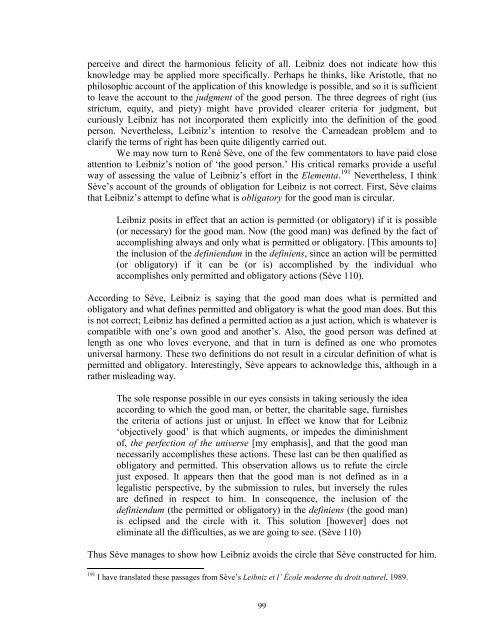Stony Brook University
Stony Brook University
Stony Brook University
Create successful ePaper yourself
Turn your PDF publications into a flip-book with our unique Google optimized e-Paper software.
perceive and direct the harmonious felicity of all. Leibniz does not indicate how this<br />
knowledge may be applied more specifically. Perhaps he thinks, like Aristotle, that no<br />
philosophic account of the application of this knowledge is possible, and so it is sufficient<br />
to leave the account to the judgment of the good person. The three degrees of right (ius<br />
strictum, equity, and piety) might have provided clearer criteria for judgment, but<br />
curiously Leibniz has not incorporated them explicitly into the definition of the good<br />
person. Nevertheless, Leibniz’s intention to resolve the Carneadean problem and to<br />
clarify the terms of right has been quite diligently carried out.<br />
We may now turn to René Sève, one of the few commentators to have paid close<br />
attention to Leibniz’s notion of ‘the good person.’ His critical remarks provide a useful<br />
way of assessing the value of Leibniz’s effort in the Elementa. 191 Nevertheless, I think<br />
Sève’s account of the grounds of obligation for Leibniz is not correct. First, Sève claims<br />
that Leibniz’s attempt to define what is obligatory for the good man is circular.<br />
Leibniz posits in effect that an action is permitted (or obligatory) if it is possible<br />
(or necessary) for the good man. Now (the good man) was defined by the fact of<br />
accomplishing always and only what is permitted or obligatory. [This amounts to]<br />
the inclusion of the definiendum in the definiens, since an action will be permitted<br />
(or obligatory) if it can be (or is) accomplished by the individual who<br />
accomplishes only permitted and obligatory actions (Sève 110).<br />
According to Sève, Leibniz is saying that the good man does what is permitted and<br />
obligatory and what defines permitted and obligatory is what the good man does. But this<br />
is not correct; Leibniz has defined a permitted action as a just action, which is whatever is<br />
compatible with one’s own good and another’s. Also, the good person was defined at<br />
length as one who loves everyone, and that in turn is defined as one who promotes<br />
universal harmony. These two definitions do not result in a circular definition of what is<br />
permitted and obligatory. Interestingly, Sève appears to acknowledge this, although in a<br />
rather misleading way.<br />
The sole response possible in our eyes consists in taking seriously the idea<br />
according to which the good man, or better, the charitable sage, furnishes<br />
the criteria of actions just or unjust. In effect we know that for Leibniz<br />
‘objectively good’ is that which augments, or impedes the diminishment<br />
of, the perfection of the universe [my emphasis], and that the good man<br />
necessarily accomplishes these actions. These last can be then qualified as<br />
obligatory and permitted. This observation allows us to refute the circle<br />
just exposed. It appears then that the good man is not defined as in a<br />
legalistic perspective, by the submission to rules, but inversely the rules<br />
are defined in respect to him. In consequence, the inclusion of the<br />
definiendum (the permitted or obligatory) in the definiens (the good man)<br />
is eclipsed and the circle with it. This solution [however] does not<br />
eliminate all the difficulties, as we are going to see. (Sève 110)<br />
Thus Sève manages to show how Leibniz avoids the circle that Sève constructed for him.<br />
191 I have translated these passages from Sève’s Leibniz et l’ École moderne du droit naturel, 1989.<br />
99
















